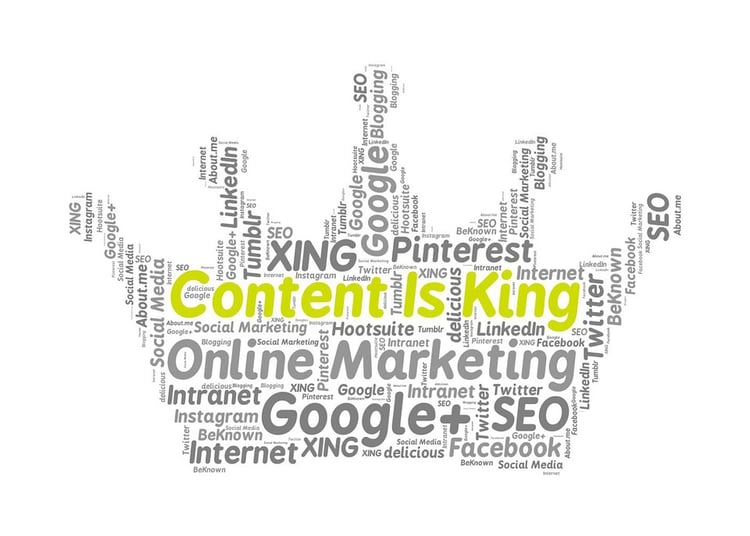How To Effectively Use Content Marketing For Lead Generation

You may have heard sentiments like these spoken about content marketing:
‘Effective lead generation depends on high-quality content.’ ‘Content is king.’ ‘Content marketing is the cornerstone of lead generation.’
Hold for a moment… all these expressions emphasise just how important content – and especially written content – is for an effective marketing strategy. But sometimes they confuse the matter by failing to explain what exactly content marketing is, and why you should bother with it at all.
In this article our intention is to cut past the jargon and hype to answer three fundamental questions about content marketing:
- What it is?
- Why we do it?
- How to do it?
What Is Content Marketing?
For us, content marketing is a straightforward proposition. Let’s try this as a definition:
Content marketing involves defining a target customer base, then creating valuable content for them with the purpose of encouraging engagement with your business.
Where some businesses go wrong with content marketing is to confuse it with SEO writing, or press releases. It isn’t that at all.
Content marketing differs from sales and many other types of marketing in that it is not a direct sales approach. The point is to give something away that your target audience will find useful, without any strings attached. It isn’t about your latest promotion or even primarily about your business.
The magic of content marketing is the effect it has on encouraging your target customers to start thinking of you as a knowledgeable authority in your field. Authoritative businesses are good people to do business with. Hence the effectiveness of content marketing as a lead generation tool. If your content addresses a problem and proposes a solution, the reader will very likely become interested in what else you have to offer. The journey from stranger to customer begins at this point. To answer our why and how questions, we will look at each of the three underlined phrases in our definition.
Defining A Target Customer
Content is entirely useless if you have no idea who you are creating it for. You have to focus content towards your audience, and to do this you need to define who your customers are. Specifically, you should think of what sort of problems your customers have that draw them to seek out businesses like yours. What questions do they ask? What role do you fill in their working life?
You can start your content marketing strategy by making a note of 10 of the most common questions you have been asked by customers, or even by strangers about your business. Back this up with a little bit of keyword research to see what queries people are typing into Google. In a matter of minutes you’ve got 10 content ideas and an idea of how to phrase them in a form that people are actually searching for. Now you can create a blog or content piece to address each question.
Creating Valuable Content
Content can take different forms. We recommend you create a mixture of the following:
- Written content: Write varied and interesting blog articles, guest posts, landing pages, white papers and eBooks.
- Image content: Create snappy looking infographics and flowcharts as informative eye candy.
- Video content: Record webinars, video diaries, presentations, animations and instruction videos.
- Audio content: Create a podcast giving handy tips, presenting interviews and providing free assistance to your customers.
You don’t have to follow a formula with any of this. Be cheeky, be creative, be factual, be funny, be clever. Create whatever content resonates with your customers, in a style they can relate to. And do it consistently, rather than as a one-off.
Content marketing is a long-term strategy – you will get nowhere by merely dabbling in it.
The key word in this mix is valuable. You really do need to hit the nail on the head by understanding what information your customers want and providing it for them.
Encouraging Engagement
Content marketing doesn’t directly sell anything, but it does encourage engagement with your brand. So you do need to have some kind of call to action in mind, whether you make this explicit in your content, or implicit. At the very least you should make your content easy to share, for instance by publishing blog posts to a mailing list in email format, or including social media share buttons on all of your videos.
Most infographics and blogs can contain back links to your website, or internal links to other content to create a cycle of interest. There is no harm in asking readers to get in touch, to sign up for a newsletter or to find out more. If you don’t ask, you don’t get, and if they like your content they have no reason for not doing so. Make it easy for your prospects to get in touch by providing clear, simple contact forms at every opportunity in your content.
Think Creatively About Lead Generation
Every man and his uncle is involved in online lead generation these days, so to get the attention of your target customers you have to think creatively. This doesn’t mean you have to reinvent the wheel each time you write a blog, but it does mean adopting a willingness to think outside the box and get inside the mind set of your customers. To help kick start the process, we have written a free guide to 30 Lead Generation Tips. It is full of practical advice you can implement right away and that are guaranteed to breathe a new lease of life into your marketing strategy.
Click here to download your copy.


